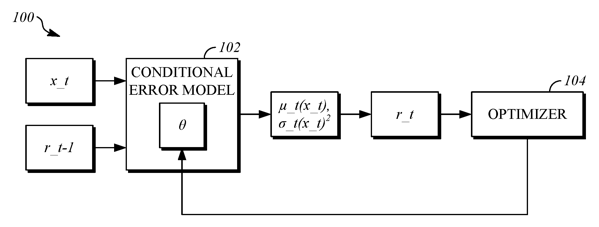| US 11,714,388 B1 | ||
| Conditional error models | ||
| Ashish Shrivastava, Santa Clara, CA (US); Cuneyt Oncel Tuzel, Cupertino, CA (US); and Shahab Kaynama, Mountain View, CA (US) | ||
| Assigned to APPLE INC., Cupertino, CA (US) | ||
| Filed by Ashish Shrivastava, Santa Clara, CA (US); Cuneyt Oncel Tuzel, Cupertino, CA (US); and Shahab Kaynama, Mountain View, CA (US) | ||
| Filed on Jul. 12, 2019, as Appl. No. 16/509,536. | ||
| Claims priority of provisional application 62/789,598, filed on Jan. 8, 2019. | ||
| Claims priority of provisional application 62/717,204, filed on Aug. 10, 2018. | ||
| Int. Cl. G05B 13/02 (2006.01); G06N 20/00 (2019.01); G06F 30/20 (2020.01); G05D 1/00 (2006.01) | ||
| CPC G05B 13/0265 (2013.01) [G06F 30/20 (2020.01); G06N 20/00 (2019.01); G05D 1/0088 (2013.01)] | 21 Claims |

|
1. A method, comprising:
obtaining first sensor outputs that represent actual states of a dynamic object using a first sensor that is located in the dynamic object; storing actual state values for the dynamic object that are based on the first sensor outputs; obtaining a second sensor output using a second sensor that is located in a subject vehicle, wherein the second sensor output represents an observation of the dynamic object; determining estimated locations of the dynamic object based on the second sensor output using a sensing algorithm; storing estimated location values corresponding to the estimated locations of the dynamic object; defining training samples that include the actual state values, the actual state values including an actual location value for the dynamic object at a time point, a respective one of the estimated location values corresponding to the time point, and an actual error value that is defined as a difference between the actual location value and the respective one of the estimated location values; training a machine learning model using the training samples such that the machine learning model is configured to determine a condition-dependent error distribution that is conditioned on inputs that represent simulated states of a simulation and represents an error during determination of estimated locations of simulated dynamic objects; and subsequent to training the machine learning model, performing one or more iterations of a simulation that includes:
determining an error value using the machine learning model,
determining a simulated sensing system output using the error value, and
controlling operation of a simulated subject vehicle based on the simulated sensing system output.
|